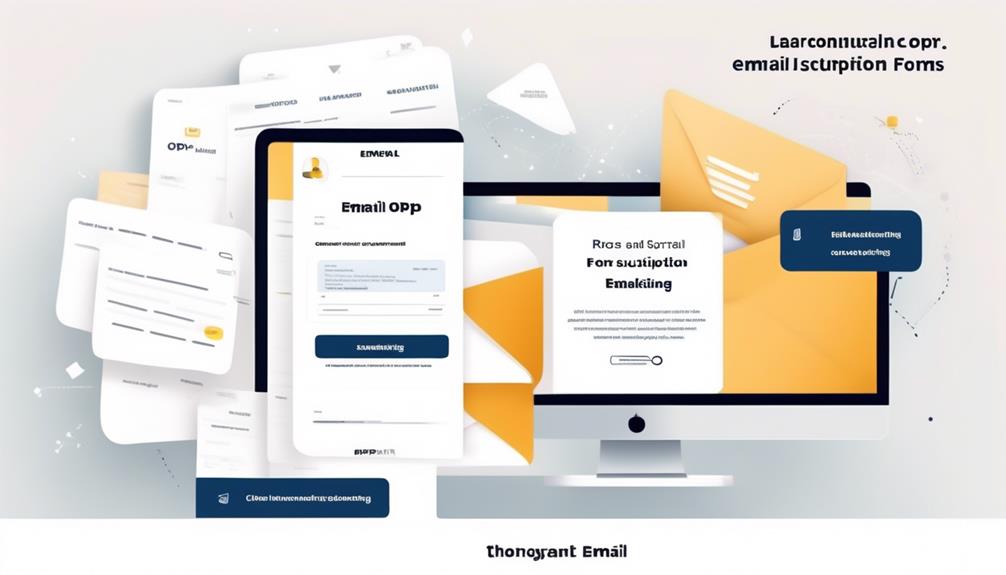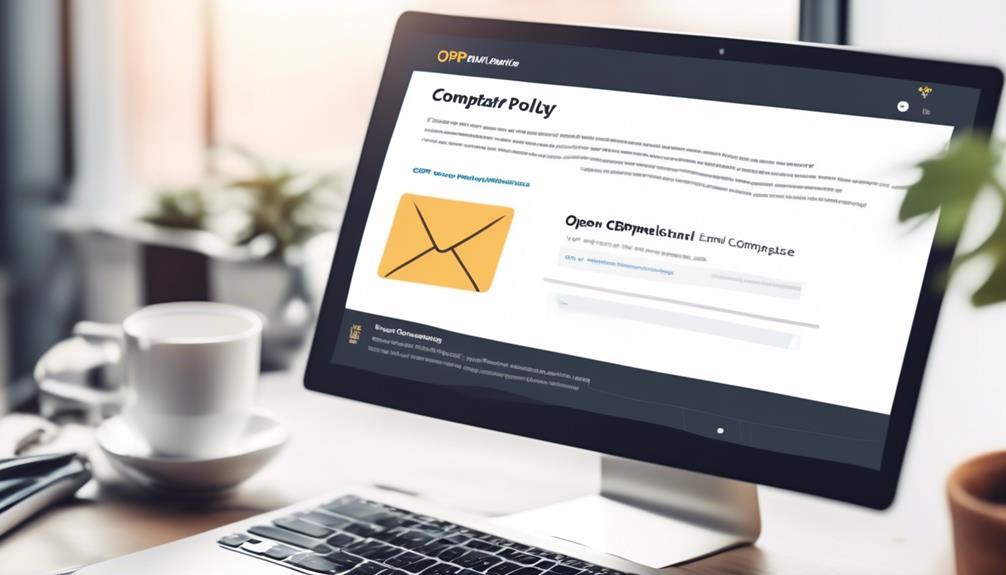We have all been in situations where we receive an unexpected email, causing us to wonder how our contact information was obtained in the first place. It’s like finding a flyer for a new restaurant in your mailbox, even though you have never expressed any interest in dining out.
As email marketers, we understand the importance of gaining consent from our subscribers before bombarding them with promotional content. However, navigating the intricacies of GDPR compliance in email marketing can be a daunting task.
How can we ensure that our consent requests are transparent and unambiguous? Let's explore some practical examples and guidelines to steer us in the right direction.
Key Takeaways
- Use clear and straightforward language in consent forms to build credibility and trust with the audience.
- Avoid pre-ticked checkboxes and ensure that users actively select unticked checkboxes to give consent.
- Emphasize the separation of consent and legal policies to maintain compliance with regulations.
- Use clear and easily understandable language in consent terms, avoiding ambiguity and using clear affirmative phrases.
Transparent Consent Requests
Transparent consent requests are an integral part of GDPR compliance and involve using clear, straightforward language to explain the purpose of consent and how the data will be used. When obtaining consent for email marketing or any data processing activities, it's crucial to ensure that the language used in consent forms is easily understandable.
Clearly naming your organization and disclosing any third parties involved is essential. This transparency instills trust and demonstrates respect for the user's data privacy. Avoiding complex phrasing and being transparent about the purpose of data collection and usage are key aspects of transparent consent requests.
It's important to clearly explain why the data is needed and what'll be done with it, ensuring users have a clear understanding before providing consent. By doing so, organizations not only adhere to GDPR requirements but also build credibility and trust with their audience.
Ultimately, transparent consent requests play a pivotal role in fostering positive relationships with users and demonstrating a commitment to ethical and lawful data processing practices.
Avoid Pre-Ticked Checkboxes
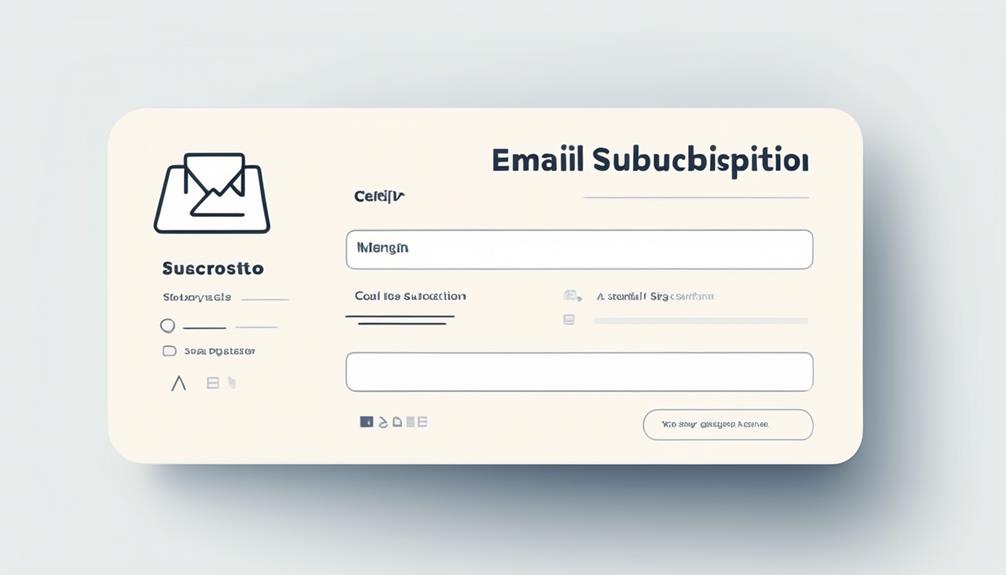
We must ensure that our consent forms don't use pre-ticked checkboxes to comply with GDPR requirements. Using pre-ticked checkboxes isn't allowed under GDPR consent requirements, as consent must be freely given.
To ensure compliance and transparency, here are three key considerations for GDPR consent forms:
- Active Opt-In: Users should be required to actively select unticked checkboxes to give consent. This ensures that consent is freely given and unambiguous, meeting the lawful basis for processing under GDPR.
- Avoid Implied Consent: It's important to avoid using pre-ticked checkboxes, implied consent, or default consent methods. Users must take a positive action to provide clear and unambiguous consent.
- Right to Withdraw Consent: Consent examples should clearly convey to users their right to withdraw their consent at any time. Providing clear instructions on how to withdraw consent reinforces transparency and empowers users to manage their consent preferences.
Separate Consent and Legal Policies
When providing examples and guidance for GDPR email marketing consent, it's crucial to emphasize the importance of separate consent and legal policies.
This involves ensuring clear consent terms, using unambiguous language, and maintaining compliance with regulations.
Clear Consent Terms
To ensure clarity and transparency, it's essential to separate consent requests from legal terms and conditions in email marketing communications. When crafting clear consent terms, it's important to use language that's easily understandable and avoids ambiguity. To achieve this, consider using clear affirmative phrases that leave no room for misinterpretation.
Additionally, ensure that your consent forms are straightforward and prominently displayed, with no pre-ticked checkboxes. Furthermore, provide easy access to your privacy policies and clearly outline the process for users to withdraw consent if they choose to do so.
Unambiguous Language Use
As we move on to 'Unambiguous Language Use', it's crucial to distinctly separate consent requests from legal terms and conditions in email marketing communications.
To ensure GDPR compliance, it's essential to use clear and unambiguous language when seeking consent from individuals. When crafting consent requests, it's important to avoid combining them with other matters, such as terms of service or privacy policies. By keeping consent requests separate from legal jargon, recipients can better understand the nature of the consent being sought.
This approach also aligns with GDPR's requirement for specific and informed consent for separate things. Therefore, in our processing operations, we must be diligent in using unambiguous language to clearly present consent requests without intertwining them with legal policies.
This not only demonstrates our commitment to GDPR compliance but also enhances transparency and trust in our email marketing practices.
Compliance With Regulations
Compliance with GDPR regulations requires clear separation of consent requests from legal terms and conditions in email marketing communications. To ensure that your email marketing efforts are GDPR compliant, the following steps should be taken:
- Separate Consent Requests: Consent must be clearly distinguishable from legal policies to ensure compliance with GDPR.
- Enable Right to Withdraw: Users should have the right to withdraw their consent at any time, as per GDPR requirements.
- Proof of Consent: Maintain records to demonstrate that valid consent has been obtained, including details of what the individual has consented to and when and how this consent was obtained.
Granular Consent Options
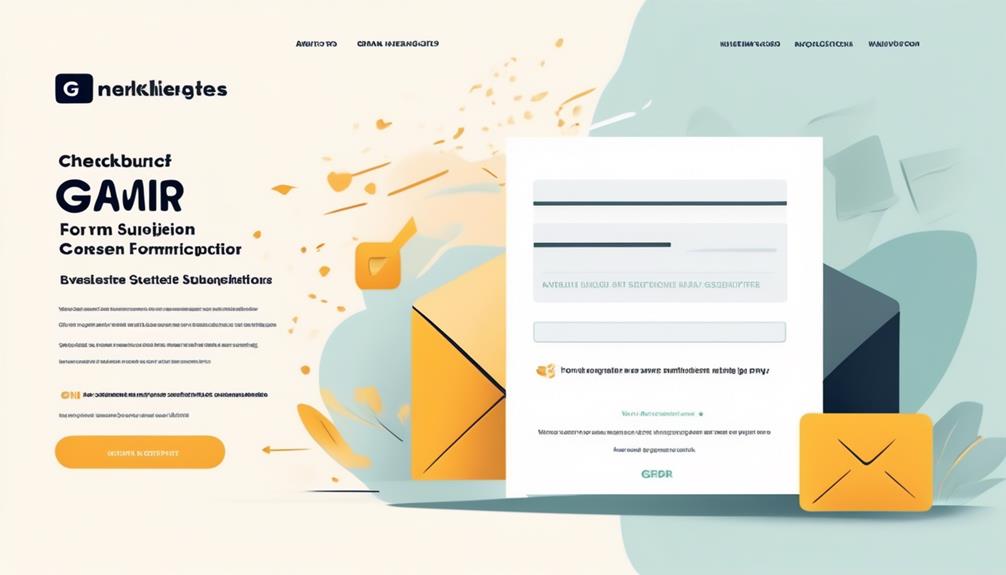
Granular consent options in email marketing allow individuals to provide specific consent for different types of data processing activities. This empowers them to make informed decisions about how their data is utilized.
This approach provides users with the ability to choose consent preferences for various marketing communications separately, including email, SMS, or postal communication. By offering clear and detailed consent choices, organizations ensure transparency and control over individuals' personal data, crucial for GDPR compliance.
With granular consent options, users can opt-in or opt-out of specific types of data usage, aligning with the GDPR's emphasis on empowering individuals to exercise control over their personal data.
This level of control not only benefits users but also helps organizations build trust and demonstrate their commitment to data privacy. Granular consent options are an essential aspect of GDPR compliance, as they enable organizations to respect users' preferences and provide them with meaningful choices regarding the processing of their personal data.
Easy Withdrawal of Consent
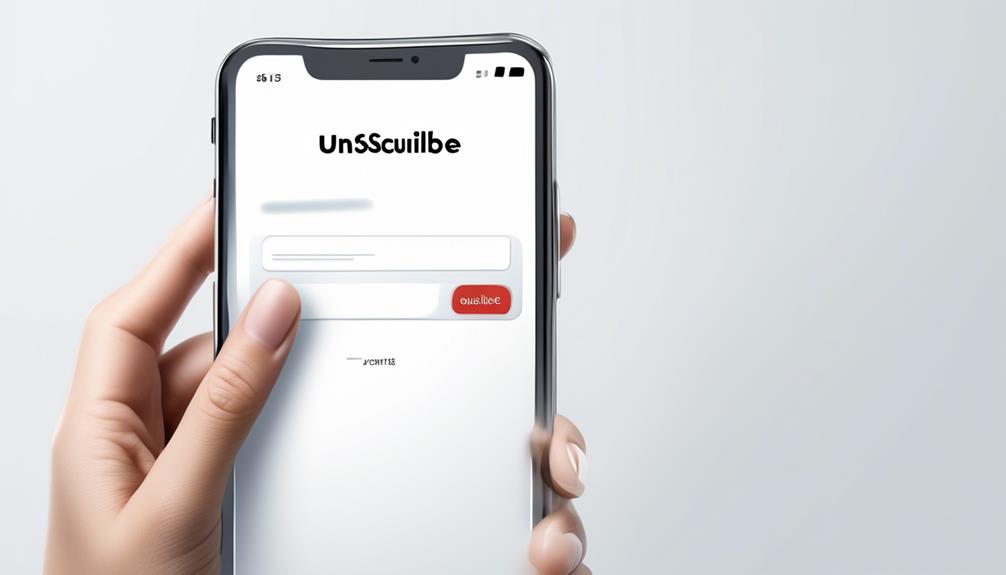
Ensuring individuals can effortlessly revoke their consent for data processing is a fundamental tenet of GDPR compliance and essential for maintaining trust and transparency in email marketing practices. GDPR requires that individuals have the right to withdraw their consent at any time, and as such, email marketers must facilitate easy withdrawal of consent.
Here are key strategies to achieve this:
- Separate Consent: Obtain separate consent for different types of processing activities, ensuring that individuals can revoke consent for specific purposes without affecting other consents.
- Double Opt-in: Implement a double opt-in process, where individuals confirm their consent twice before being added to a mailing list. This not only ensures explicit consent but also provides a clear path for withdrawal.
- Unsubscribe Link: Include a prominent and easily accessible unsubscribe link in all marketing emails. This allows individuals to withdraw their consent effortlessly, without encountering barriers or delays.
Recordkeeping for Consent
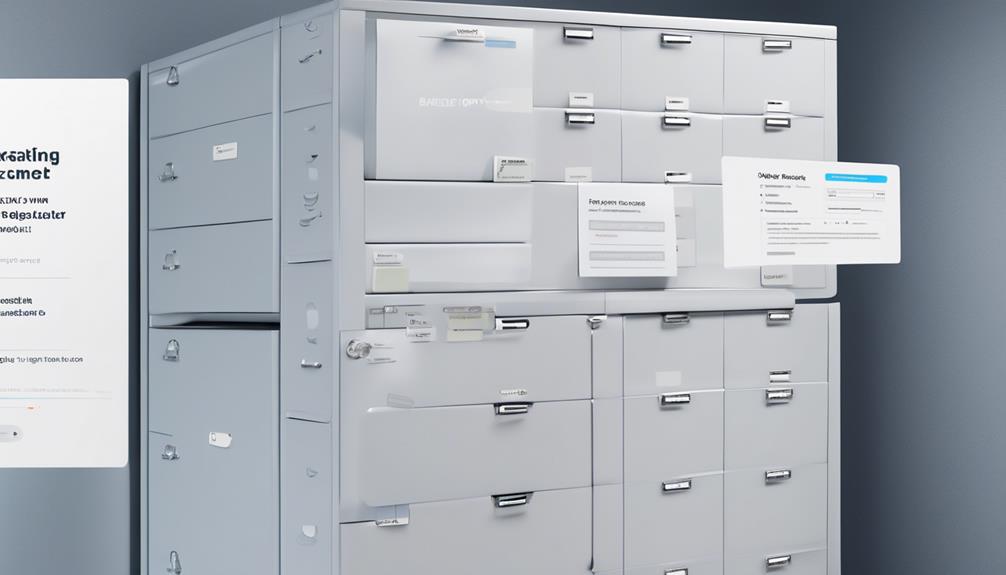
Maintaining trust and transparency in email marketing practices, we must adhere to GDPR's requirement for recordkeeping of consent choices, including the method and timing of individuals' consent, as we move into the subtopic of 'Recordkeeping for Consent'.
Recordkeeping for consent is a crucial aspect of GDPR compliance in email marketing. It involves maintaining detailed records of how and when individuals provided consent, what they were informed about at the time of consent, and the specific method used for obtaining their consent, such as through an opt-in form or another explicit action.
These records are essential for demonstrating compliance with GDPR requirements and for providing evidence in case of any disputes or regulatory inquiries. Effective recordkeeping ensures that organizations can prove they obtained valid consent from individuals and that they've respected individuals' choices regarding their personal data.
Additionally, maintaining accurate consent records enables organizations to promptly honor requests for withdrawal of consent, as required by GDPR.
Information to Record for Consent
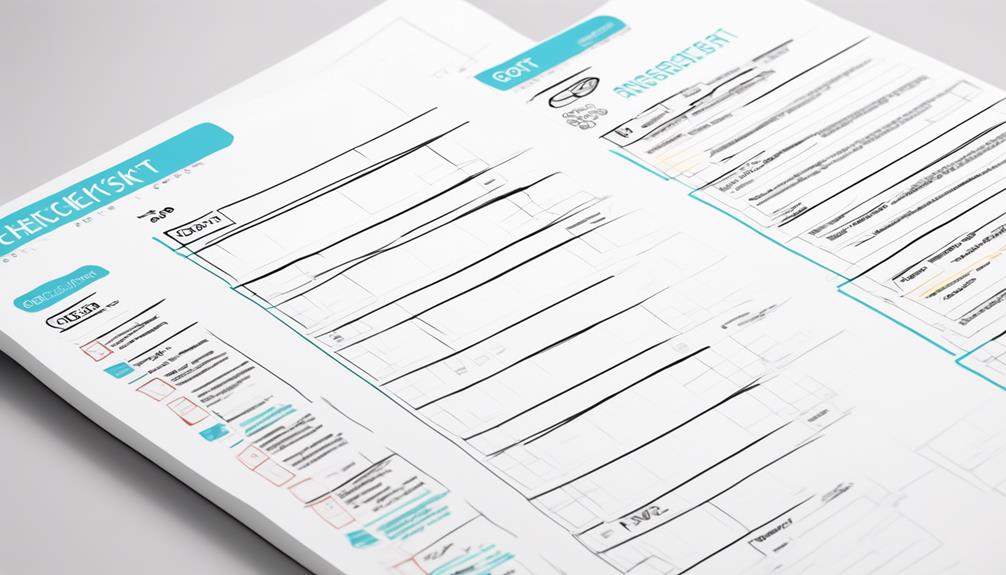
To ensure comprehensive compliance with GDPR requirements, it's crucial to accurately record specific details when obtaining consent for email marketing purposes. When recording consent for GDPR email marketing, the following information should be carefully documented:
- Date and Time: Record the exact date and time when consent was given, as this is crucial for demonstrating compliance with GDPR requirements and for potential future audits.
- Method of Consent: Document the method through which consent was obtained, whether it was through an online form, verbal agreement, or any other means. This ensures transparency and accountability in the consent process.
- Purpose and Use of Data: Specify the purpose for which consent is given and how the data will be used. This includes providing clear information on the intended use of the data and the specific marketing activities it relates to.
It's important to note that relying on pre-ticked checkboxes or implied consent isn't considered valid under GDPR. Seek legal advice to ensure that the information recorded for consent aligns with the legal requirements and best practices for GDPR email marketing compliance.
User Consent Management
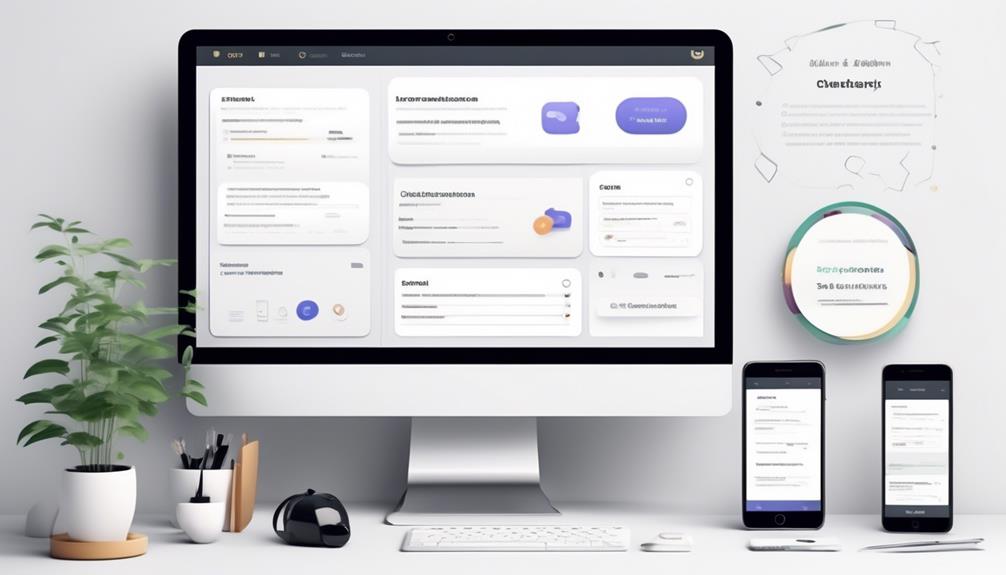
Now, let's address the crucial aspects of user consent management.
We'll explore the optimal opt-in consent process, the importance of providing consent withdrawal options, and the necessity of data retention compliance.
These points are fundamental for ensuring that our email marketing practices align with GDPR regulations and respect user privacy.
Opt-In Consent Process
Implementing an effective opt-in consent process is crucial for ensuring compliance with GDPR regulations on user consent management. To achieve this, we need to:
- Obtain specific, informed, and unambiguous consent from individuals, allowing them the right to easily withdraw consent. This ensures that individuals are fully aware of the privacy implications of their consent.
- Consider implementing a double opt-in consent request for mailing lists, although it isn't explicitly required by GDPR, to ensure a robust verification process.
- Provide users with a way to manage their consent choices, including the ability to change their minds at any time, as required by the General Data Protection Regulation.
Consent Withdrawal Options
Ensuring that users have straightforward and accessible options to withdraw their consent is a fundamental aspect of GDPR compliance and user consent management. Providing clear and easy-to-use consent withdrawal options is essential for respecting users' rights under GDPR. Users must have the ability to change their consent preferences at any time, as the basis for processing data relies on their freely given consent. To facilitate this, websites should offer consent preference centers and Data Subject Access Request (DSAR) forms that are easily accessible. Below is a table outlining some common consent withdrawal options:
| Consent Withdrawal Options | Description |
|---|---|
| Preference Center | Online platform for users to manage their consent choices |
| DSAR Form | Form for users to request access to and control over their personal data |
| Soft Opt-In | Allowing users to opt out of consent easily, even after initially giving consent |
Data Retention Compliance
Data retention compliance is a critical aspect of user consent management under GDPR, requiring organizations to carefully oversee and document user consent throughout the data lifecycle. To ensure compliance, organizations should:
- Record and store consent data, including details of when, how, and what users consented to, as part of their privacy policy.
- Enable users to easily withdraw their consent, in accordance with GDPR requirements, by providing clear and accessible withdrawal options.
- Consider implementing a double opt-in process for obtaining and managing user consent for mailing lists, and explore alternative methods for obtaining unambiguous consent, such as using pop-ups, based on applicable laws and proper notice to users.
Effective data retention compliance is essential for organizations to align their practices with GDPR and ensure the lawful processing of personal data.
GDPR Compliant Opt-in Examples
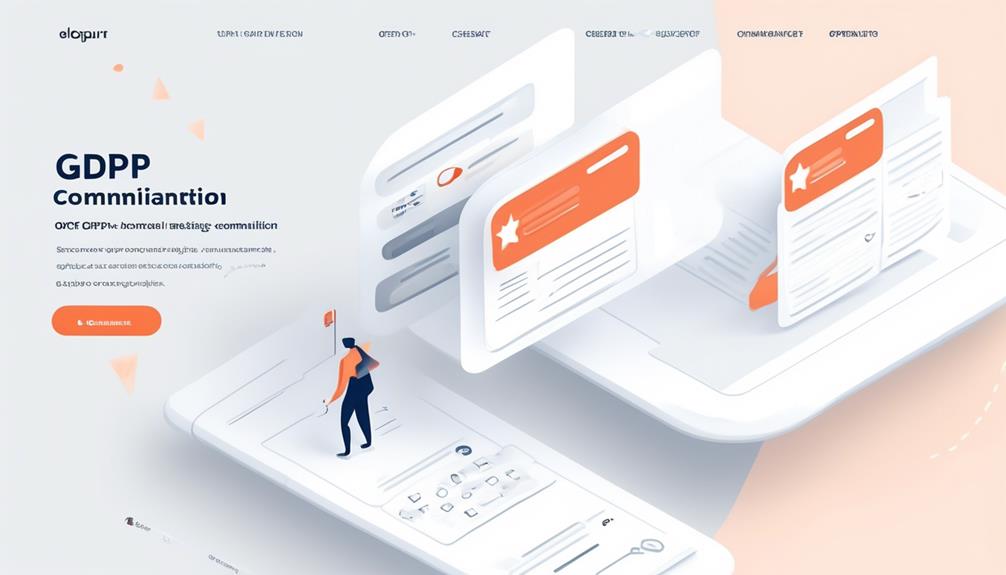
When seeking GDPR-compliant opt-in examples for email marketing, it's crucial to ensure that consent is specific, informed, and unambiguous, in line with GDPR regulations.
One effective example of GDPR-compliant opt-in consent involves using clear, unambiguous language to explain to users that by providing their email address, they're consenting to receive marketing communications. This explanation should also outline how their personal data will be used, emphasizing transparency.
Additionally, it's important to avoid pre-ticked checkboxes or any form of implied consent, as these practices don't align with GDPR requirements.
Implementing a double opt-in process for mailing lists can also serve as a best practice, although it isn't explicitly mandated by GDPR. This process involves sending a confirmation email to the user after they initially opt-in, requiring them to take a further action to confirm their subscription.
It's also crucial to provide users with a simple way to withdraw their consent, as per GDPR guidelines, ensuring that they can easily opt out of receiving marketing communications.
Opt-in Form Examples
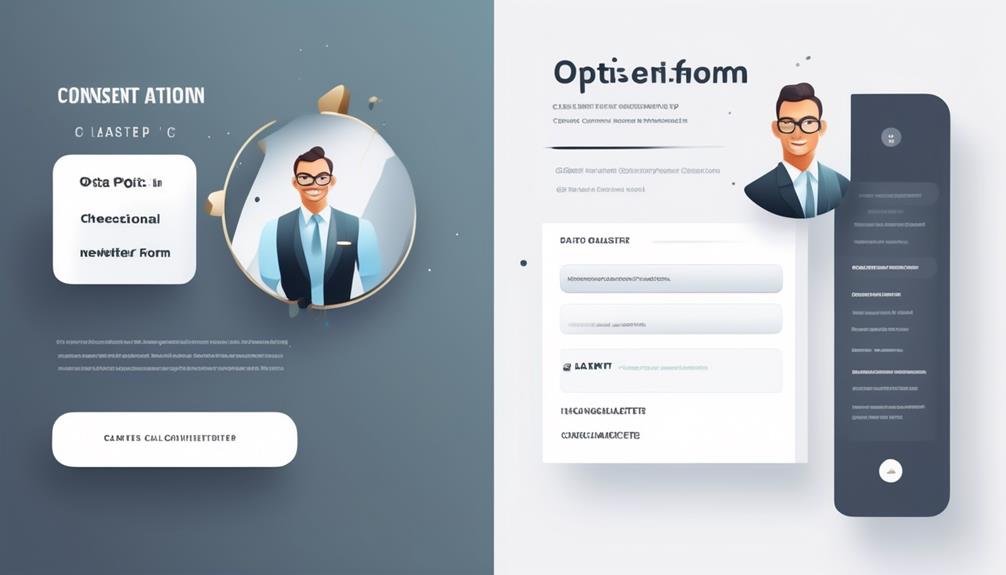
To enhance user understanding and compliance with GDPR regulations, opt-in form examples should utilize clear and straightforward language to request consent. When creating opt-in forms for email marketing, it's crucial to follow GDPR guidelines and best practices. Here are three key elements to consider when designing opt-in forms:
- Clear and Unambiguous Language: Opt-in forms should use language that's easy to understand and free from ambiguity. Clearly state what the user is consenting to, such as receiving marketing emails or sharing their data with third parties.
- Unticked Checkboxes: Avoid using pre-ticked checkboxes, implied consent, or default consent. Instead, present users with unticked checkboxes that they must actively select to give consent. This ensures that consent is explicit and affirmative.
- Double Opt-In Consent: Consider implementing a double opt-in process for mailing lists. After users fill out the online consent form, they should be required to confirm their email address to verify their consent.
Effective Permission Reminders
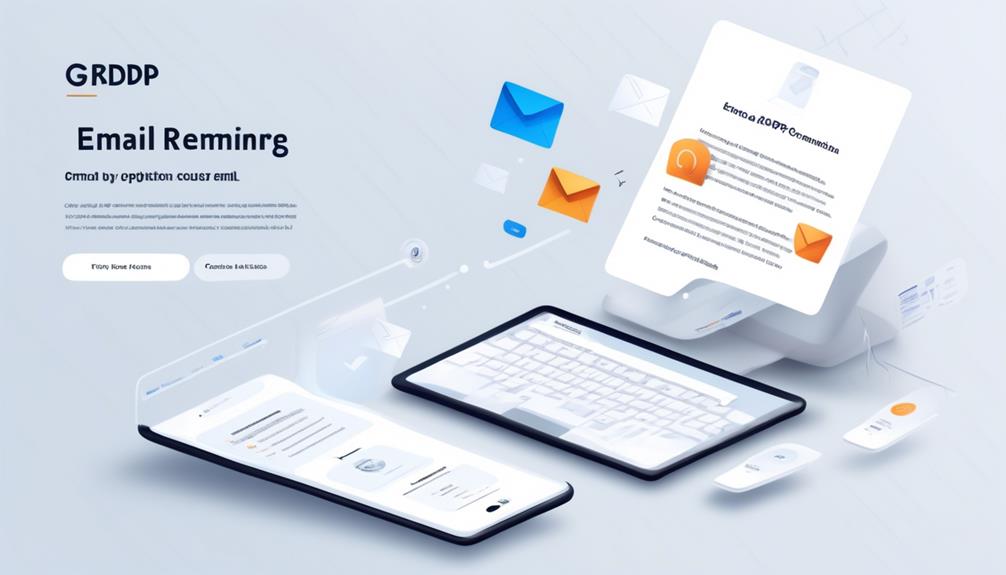
As we shift our focus to 'Effective Permission Reminders', it's essential to maintain clarity and transparency in our communication with users regarding their consent for email marketing. Effective permission reminders should clearly explain why the data is being collected and how it will be used to maintain transparency with users. Utilize clear and specific language to request consent, avoiding pre-ticked checkboxes or vague statements to ensure understanding and meet GDPR requirements. Consider implementing double opt-in consent for mailing lists as a best practice, even though it is not explicitly required by GDPR, to verify and record user consent. Provide users with easy ways to manage their consent choices, including the ability to withdraw consent and access a consent preference center on the website, as required by GDPR. Below is a table summarizing the key points for creating effective permission reminders in GDPR email marketing.
| Key Points | Description |
|---|---|
| Clearly Explain Data Collection and Use | Explain why the data is being collected and how it will be used to maintain transparency with users. |
| Utilize Clear and Specific Language for Consent | Avoid pre-ticked checkboxes or vague statements to ensure understanding and meet GDPR requirements. |
| Provide Easy Consent Management Options | Offer users easy ways to manage their consent choices, including the ability to withdraw consent and access a consent preference center on the website. |
GDPR Compliant Email Marketing Examples
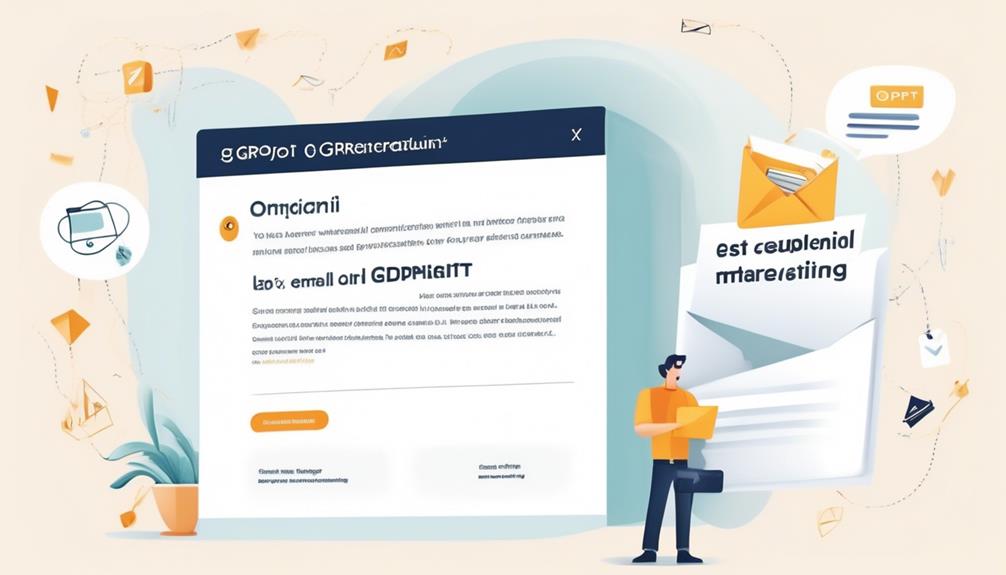
In our pursuit of GDPR compliance in email marketing, we exemplify best practices through clear and explicit consent procedures that prioritize user understanding and choice.
When implementing GDPR compliant email marketing, we ensure that consent is freely given, specific, informed, and unambiguous. We avoid non-compliant checkbox usage, such as pre-ticked checkboxes and implied consent, as they violate GDPR.
Additionally, we consider implementing a double opt-in consent request for mailing lists, although it's not explicitly required by GDPR. We also provide alternative methods for unambiguous consent, such as pop-ups asking users to enter their email address with clear phrases and labeled buttons.
Furthermore, we prioritize making it easy for users to withdraw consent, and we maintain a record of consent choices, including when, how, and what users consented to, in accordance with GDPR requirements.
Frequently Asked Questions
How Do I Write a GDPR Consent Form?
We write GDPR consent forms by ensuring they're freely given, specific, informed, and unambiguous, as required by GDPR.
We avoid pre-ticked checkboxes and use clear, easy-to-understand language in consent requests.
Consider implementing a double opt-in consent request for mailing lists and provide alternative methods for obtaining unambiguous consent.
Allow users to easily manage their consent choices and provide a way for them to withdraw consent, as per GDPR requirements.
How Do I Comply With GDPR Email Marketing?
We comply with GDPR email marketing by obtaining freely given, specific, informed, and unambiguous consent. We avoid non-compliant checkbox usage, implement double opt-in consent when possible, and utilize alternative methods for unambiguous consent, such as clear pop-ups and labeled buttons.
We also provide users with the ability to manage their consent choices and easily withdraw consent. These practices ensure compliance with GDPR requirements for email marketing.
What Is GDPR Compliant Consent Wording?
We ensure GDPR compliant consent by using clear, specific, and unambiguous language in our consent requests. We identify ourselves and disclose any third parties involved.
To avoid non-compliant checkbox usage, we require users to actively select unticked checkboxes for consent. For mailing lists, we implement double opt-in consent requests, where users confirm their email address.
Alternative methods like pop-ups with clear phrases and labeled buttons also comply with GDPR.
What Is an Example of Consent Email?
Sure!
An example of a consent email would be one that clearly outlines what data is being collected and how it will be used. It provides an option to easily withdraw consent and uses explicit language for permission.
It's important to avoid pre-ticked checkboxes or implied consent. Double opt-in requests are a best practice. Using clear phrases and labeled buttons can also help ensure unambiguous consent.
Can You Provide Examples of GDPR-Compliant Email Marketing Consent?
Yes, I can provide examples of GDPR-compliant email marketing consent. One example is clearly outlining how the subscriber’s data will be used and obtaining explicit gdpr consent for email marketing. Another example is providing a clear and easy opt-in process for subscribers to give their consent for email marketing under GDPR regulations.
Conclusion
In conclusion, ensuring GDPR compliance in email marketing is crucial for protecting the privacy and rights of subscribers. By implementing transparent consent requests, granular options, and easy withdrawal processes, email service providers can help users maintain compliance.
Let's strive to avoid pre-ticked checkboxes and provide effective permission reminders to create a harmonious and respectful email marketing environment.
Together, we can navigate GDPR requirements and build trust with our subscribers, like a well-choreographed dance.
